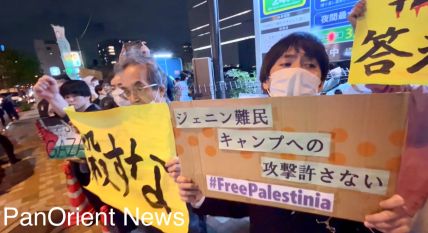|
|
Environment
Fukushima Citizens Remain Exposed to High Levels of Radiation: Greenpeace Warns
Thursday, June 9, 2011

Tokyo- (PanOrient News) Greenpeace International Executive Director Dr Kumi Naidoo criticized Japanese government’s response to the Fukushima Daiichi nuclear crisis, and its ongoing "failure" to protect the health and welfare of its people.
At a Tokyo press conference held today at the Foreign Correspondents’ Club of Japan, Dr. Naidoo unveiled a sample of contaminated soil from a Fukushima playground and said "on Tuesday I had the privilege of meeting with both teachers and school children in Fukushima. Looking at innocent faces of the children, I found it difficult to contemplate the dangerously high levels of radiation they are being exposed to on a daily basis." "While the Japanese government has made some efforts at decontamination, it is not nearly enough. These are real people we are dealing with here, not statistics."
Dr Naidoo accompanied a Greenpeace radiation monitoring team this week as it undertook further contamination testing on the streets of central Fukushima city. The team found average levels of gamma radiation contamination at around 2-3 µSv/h (microSievert per hour) at ground level, about 25-40 times above normal. The team said they were alarmed to learn that measurements at contaminated hotspots ranged from 9 µSv/h to as high as 45 µSv/h, particularly dose rates of 0.5 µSv/h - seven times normal background levels - could still be found at a kindergarten, despite having been already being decontaminated by the authorities.
The sample is two kilograms of soil collected at a city playground:
- at contact, the small amount of soil gives dose rate around 3 µSv/h
- at contact of the outside of the suitcase, the dose rate is 1.1 µSv/h
- at 1 meter distance from the suitcase, the dose rate is 0.07 µSv/h, ie back to normal
The soil is properly packaged, sealed in several layers, and carried in a robust suitcase to avoid any contamination or danger, according to Greenpeace team. They said it has a detailed radiation safety protocol for transportation and manipulation with this sample, which includes emergency preparedness. It is at all times guarded by a trained radiation specialist.
“We plan on taking this contaminated soil to Japan’s government, to demand commitment to realistic protection of those most vulnerable to radiation. The pregnant woman and children of Fukushima are the future of this country. They are innocent victims of Japan’s insistence on using nuclear energy and there is a moral imperative for them to be evacuated from high-risk areas until proper decontamination is carried out".
In the kindergarten, a radiation dose rate of 3 µSv/h was recorded in a garden, and 0.5 µSv/h in places where top soil was removed during decontamination. A reduced rate of 0.5 µSv/h could still expose one to a dose of 5 mSv per year – five times the internationally recommended maximum annual dose and a level that triggered evacuations after the Chernobyl accident in 1986.
Values around 9 µSv/h were recorded at some public places, including playgrounds, and 20 and 45 µSv/h hotspots were discovered on a road outside a school, and at a high school respectively. The readings were found near the building at places where the rainwater accumulates and flows from the roofs.
“While authorities have admitted this week that the Fukushima crisis is far worse than previously claimed by Tokyo Electric Power Company, or TEPCO, with several melt-through and a doubling of the estimated amount of radiation released, we are not seeing any escalation in their plans to protect the public. What we need here is greater protection from exposure to schoolchildren, and far less protection and more exposure of TEPCO and the rest of nuclear industry”.
PanOrient News
© PanOrient News All Rights Reserved.
|
|

